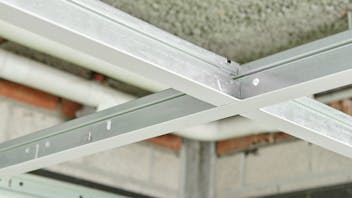Mold is a fungus that reproduces through spores that float through the air and, start growing when they land on a damp, organic substance – which can include wood, drywall and other materials used in ceiling panels.
There are many different kinds of mold. There are black molds, brown molds, white molds, gray molds, green molds and many other colors. Usually, they look like spots and sometimes have a powdery texture. Mildew is a particular type of mold with a flat growth pattern. As mold grows and spreads, it damages and destroys the material on which it’s living.
Because our stone wool and metal ceiling products are not organic, they do not promote the growth of mold or bacteria. Through their inherent material makeup, there is no need to incorporate fungicides or antimicrobials to achieve these mold-resistant properties.
Is exposure to mold dangerous?
Exposure to mold can be potentially dangerous to people, causing skin infections, pneumonia and other airborne illnesses.1
The Centers for Disease Control and Prevention (CDC) cautions, “If you can see or smell mold, a health risk may be present.”
Our water-repellent stone wool and metal ceiling tiles, panels, planks, and grids do not accumulate moisture. They do not support mold or microbial growth. They have no nutritional value and therefore provide no sustenance to harmful microorganisms like:
- Methicillin-Resistant Staphylococcus Aureus (MRSA), bacteria resistant to antibiotics and responsible for post-surgery infections and septicaemias
- Candida Albicans, yeast responsible for skin infections and pneumonia
- Aspergillus Niger, mold responsible for pneumonia
North American studies show a relationship between mold and damp conditions, and health effects such as an increase in allergic reactions, and eye, nose, and throat irritation.2


















